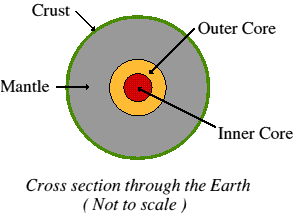

Our planet was most probably created about five billion years ago. At first it was just a ball of molten rock and gasses with little order to its structure. The immense amount of heat energy released at this time is still being radiated, even today, as the planet slowly cools down.
As the cooling began, more dense materials such as iron (Fe) sank into the core of the Earth, while lighter silicates (Si), other oxygen (O) compounds, and water rose towards the surface. In consequence distinct layers began to form.
The Earth is made up of several of these different layers. The outer layer is called the Crust and is made of the lighter, less dense, rocks that floated to the surface when the Earth was formed.
The layer of rock below the crust is called the Mantle This is about 2,900km thick and contains most of the mass of the Earth.
Below the mantle is the Core. This is probably liquid with a solid centre made of iron with a few other metals such as nickel.
Exercises
a. Read about the Crust, the Mantle and the Core, then complete a table like the one below to show the key features of each section, such as thickness, whether the rocks are solid, plastic or liquid, and other characteristic features.
Crust |
Mantle |
Core |
| Continental 35-70km | About 2900km thick | Diameter of
6740km
|
b. There are two types of crustal rocks referred to as SIAL and SIMA. What are they made of, where are they found, and why is SIAL usually found above SIMA?
c. Temperatures increase towards the centre of the Earth, so why does the inner core seem to be solid, not liquid like the outer core?
d. The Mantle is an area where a process called convection takes place. Find out what this means. Convection cells in the mantle work in a way similar to the way soup moves in a hot pan. Draw a simple diagram to show how soup might move in a pan as it is heated over a stove. Hint : the center of the pan base will be hottest, and the edges coolest.
Click to go back